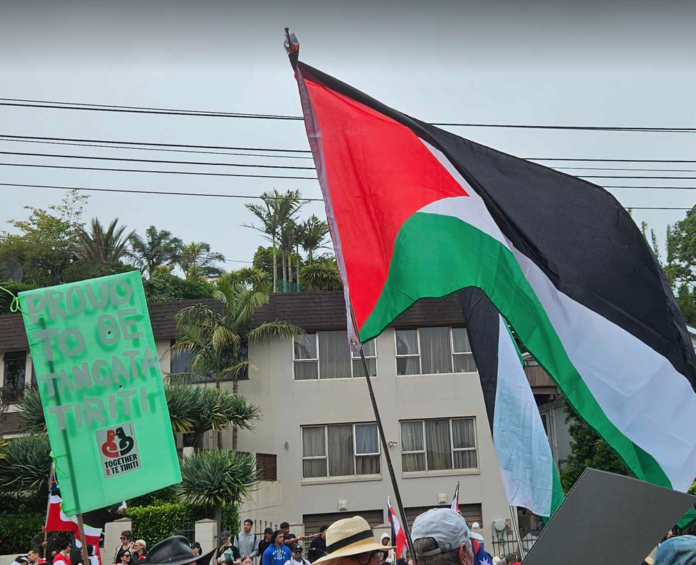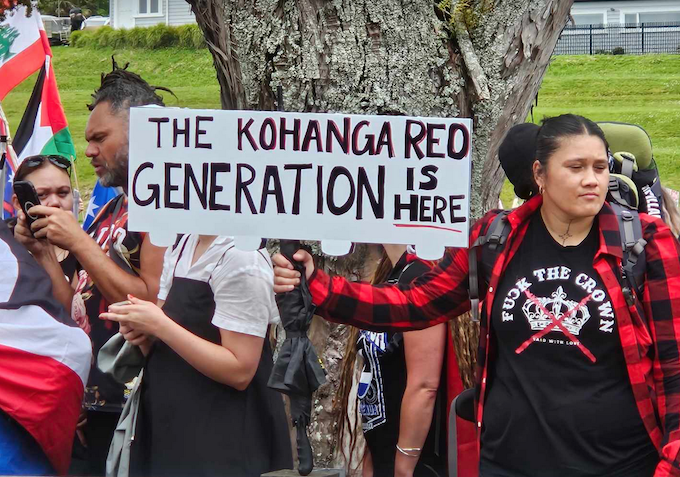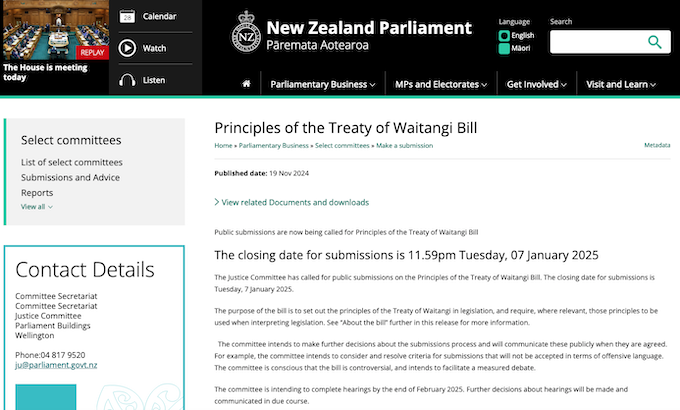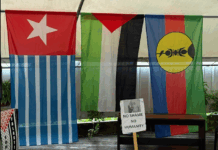
An overview for our international readers of Asia Pacific Report.
BACKGROUNDER: By Sarah Shamim
A fight for Māori indigenous rights drew more than 50,000 protesters to the New Zealand Parliament in the capital Wellington yesterday.
A nine-day-long Hīkoi, or peaceful march — a Māori tradition — was undertaken in protest against a bill that seeks to “reinterpret” the country’s 184-year-old founding Treaty of Waitangi, which was signed between British imperial colonisers and the Indigenous Māori tangata whenua (people).
Some had also been peacefully demonstrating outside the Parliament building for nine days before the protest concluded yesterday.
- READ MORE: Bill would ‘render the treaty worthless’ – world reacts to national Hīkoi
- ‘What’s good for Māori is good for everyone’ – Hīkoi ends with peaceful protest
- Hīkoi day 9: Massive crowd joins as Treaty Principles Bill protest reaches Parliament
- Other Hīkoi reports
On November 14, the controversial Treaty Principles Bill was introduced in Parliament for a preliminary first reading vote. Māori parliamentarians staged a haka (a traditional ceremonial dance) to disrupt the vote, temporarily halting parliamentary proceedings.
So, what was the Treaty of Waitangi, what are the proposals for altering it, and why has it become a flashpoint for protests in New Zealand?

Who are the Māori?
The Māori people are the original residents of the two large main islands now known as New Zealand, having lived there for several centuries.
The Māori came to the uninhabited islands of New Zealand from East Polynesia on canoe voyages betweemn 1200 and 1300. Over hundreds of years of isolation, they developed their own distinct culture and language. Māori people speak te reo Māori and have different tribes, or iwi, spread throughout the country.
The two islands were originally called Aotearoa by the Māori. The name New Zealand was adopted by the colonisers who took control under the Treaty of Waitangi in 1840.
While Dutch explorer Abel Tasman was the first European to “discover” New Zealand in 1642, calling it Staten Land, three years later Dutch cartographers renamed the land Nova Zeelandia after the Dutch province of Zeeland.
British explorer James Cook later anglicised the name to New Zealand.
New Zealand became a “dominion” under the British crown in 1907 after being a colony.
It gained full independence from Britain in 1947 when it adopted the Statute of Westminster.
However, for a century the Māori people had suffered mass killings, land grabs and cultural erasure at the hands of colonial settlers.
There are currently 978,246 Māori in New Zealand, constituting around 19 percent of the country’s population of 5.3 million. They are partially represented by Te Pāti Māori — the Māori Party — which currently holds six of the 123 seats in Parliament.

What was the Treaty of Waitangi?
On February 6, 1840, the Treaty of Waitangi, also called Te Tiriti o Waitangi or just Te Tiriti in te reo, was signed between the British Crown and around 500 Māori chiefs, or rangatira. The treaty was the founding document of New Zealand and officially made New Zealand a British colony.
While the treaty was presented as a measure to resolve differences between the Māori and the British, the English and te reo versions of the treaty actually feature some stark differences.
The te reo Māori version guarantees “rangatiratanga” to the Māori chiefs. This translates to “self-determination” and guarantees the Māori people the right to govern themselves.
However, the English translation says that the Maori chiefs “cede to Her Majesty the Queen of England absolutely and without reservation all the rights and powers of Sovereignty”, making no mention of self-rule for the Maori.
The English translation does guarantee the Māori “full exclusive and undisturbed possession of their Lands and Estates Forests Fisheries”.
“The English draft talks about the British settlers having full authority and control over Māori in the whole country,” Kassie Hartendorp, a Māori community organiser and director at community campaigning organisation ActionStation Aotearoa, told Al Jazeera.
Hartendorp explained that the te reo version includes the term “kawanatanga”, which in historical and linguistic context “gives British settlers the opportunity to set up their own government structure to govern their own people but they would not limit the sovereignty of Indigenous people”.
“We never ceded sovereignty, we never handed it over. We gave a generous invitation to new settlers to create their own government because they were unruly and lawless at the time,” said Hartendorp.
In the decades after 1840, however, 90 percent of Māori land was taken by the British Crown. Both versions of the treaty have been repeatedly breached and Māori people have continued to suffer injustice in New Zealand even after independence.
In 1975, the Waitangi Tribunal was established as a permanent body to adjudicate treaty matters. The tribunal attempts to remedy treaty breaches and navigate differences between the treaty’s two texts.
Over time, billions of dollars have been negotiated in settlements over breaches of the treaty, particularly relating to the widespread seizure of Māori land.
However, other injustices have also occurred. Between 1950 and 2019, about 200,000 children, young people and vulnerable adults were subjected to physical and sexual abuse in state and church care, and a commission found Māori children were more vulnerable to the abuse than others.
On November 12 this year, Prime Minister Christopher Luxon issued an apology to these victims, but it was criticised by Māori survivors for being inadequate. One criticism was that the apology did not take the treaty into account.
While the treaty’s principles are not set in stone and are flexible, it is a significant historical document that upholds Māori rights.

What does the Treaty Principles Bill propose?
The Treaty Principles Bill was introduced by Member of Parliament David Seymour, leader of the libertarian ACT Party, a minor partner in New Zealand’s rightwing coalition government. Seymour himself is of Māori heritage.
The party launched a public information campaign about the bill on February 7 this year.
The ACT Party asserts that the treaty has been misinterpreted over the decades and that this has led to the formation of a dual system for New Zealanders, where Māori and pākehā (white) New Zealanders have different political and legal rights. Seymour says that misinterpretations of the treaty’s meaning have effectively given Māori people special treatment.
The bill calls for an end to “division by race”.
Seymour said that the principle of “ethnic quotas in public institutions”, for example, is contrary to the principle of equality.
The bill seeks to set specific definitions of the treaty’s principles, which are currently flexible and open to interpretation. These principles would then apply to all New Zealanders equally, whether they are Māori or not.
According to Together for Te Tiriti, an initiative led by ActionStation Aotearoa, the bill will allow the New Zealand government to govern all New Zealanders and consider all New Zealanders equal under the law.
Activists say this will effectively disadvantage indigenous Māori people because they have been historically oppressed.
Many, including the Waitangi Tribunal, say this will lead to the erosion of Māori rights. A statement by ActionStation Aotearoa says that the bill’s principles “do not at all reflect the meaning” of the Treaty of Waitangi.
Why is the bill so controversial?
The bill is strongly opposed by political parties in New Zealand on both the left and the right, and Maori people have criticised it on the basis that it undermines the treaty and its interpretation.
Gideon Porter, a Maori journalist from New Zealand, told Al Jazeera that most Maori, as well as historians and legal experts, agree that the bill is an “attempt to redefine decades of exhaustive research and negotiated understandings of what constitute ‘principles’ of the treaty”.
Porter added that those critical of the bill believe “the ACT Party within this coalition government is taking upon itself to try and engineer things so that Parliament gets to act as judge, jury and executioner”.
In the eyes of most Maori, he said, the ACT Party is “simply hiding its racism behind a facade of ‘we are all New Zealanders with equal rights’ mantra”.
The Waitangi Tribunal released a report on August 16 saying that it found the bill “breached the Treaty principles of partnership and reciprocity, active protection, good government, equity, redress, and the … guarantee of rangatiratanga”.
Another report by the tribunal seen by The Guardian newspaper said: “If this bill were to be enacted, it would be the worst, most comprehensive breach of the Treaty . . . in modern times.”

What process must the bill go through now?
For a bill to become law in New Zealand, it must go through three rounds in Parliament: first when it is introduced, then when MPs suggest amendments and finally, when they vote on the amended bill. Since the total number of MPs is 123, at least 62 votes are needed for a bill to pass, David MacDonald, a political science professor at the University of Guelph in Canada, told Al Jazeera.
Besides the six Māori Party seats, the New Zealand Parliament comprises 34 seats held by the Labour Party; 14 seats held by the Green Party of Aotearoa; 49 seats held by the National Party; 11 seats held by the ACT Party; and eight seats held by the New Zealand First Party.
“The National Party leaders including the PM and other cabinet ministers and the leaders of the other coalition party [New Zealand] First have all said they won’t support the bill beyond the committee stage. It is highly unlikely that the bill will receive support from any party other than ACT,” MacDonald said.
When the bill was heard for its first round in Parliament last week, Māori party lawmaker Hana-Rawhiti Maipi-Clarke tore up her copy of the legislation and led the haka.
Is the bill likely to pass?
The chances of the bill becoming law are “zero”, Porter said.
He said the ACT’s coalition partners had “adamantly promised” to vote down the bill in the next stage. Additionally, all the opposition parties will also vote against it.
“They only agreed to allow it to go this far as part of their ‘coalition agreement’ so they could govern,” Porter said.
New Zealand’s current coalition government was formed in November 2023 after an election that took place a month earlier. It comprises the National Party, ACT and New Zealand First.
While rightwing parties have not given a specific reason why they will oppose the bill, Hartendorp said New Zealand First and the New Zealand National Party would likely vote in line with public opinion, which largely opposes it.
Why are people protesting if the bill is doomed to fail?
The protests are not against the bill alone.
“This latest march is a protest against many coalition government anti-Māori initiatives,” Porter said.
Many believe that the conservative coalition government, which took office in November 2023, has taken measures to remove “race-based politics”. The Māori people are not happy with this and believe that it will undermine their rights.
These measures include removing a law that gave the Maori a say in environmental matters. The government also abolished the Maori Health Authority in February this year.
Despite the bill being highly likely to fail, many believe that just by allowing the bill to be tabled in Parliament, the coalition government has ignited dangerous social division.
For example, former conservative Prime Minister Jenny Shipley has said that just putting forth the bill is sowing division in New Zealand, and she warned of potential “civil war”.
Sarah Shamim is a freelance writer and assistant producer at Al Jazeera Media Network, where this article was first published.










































